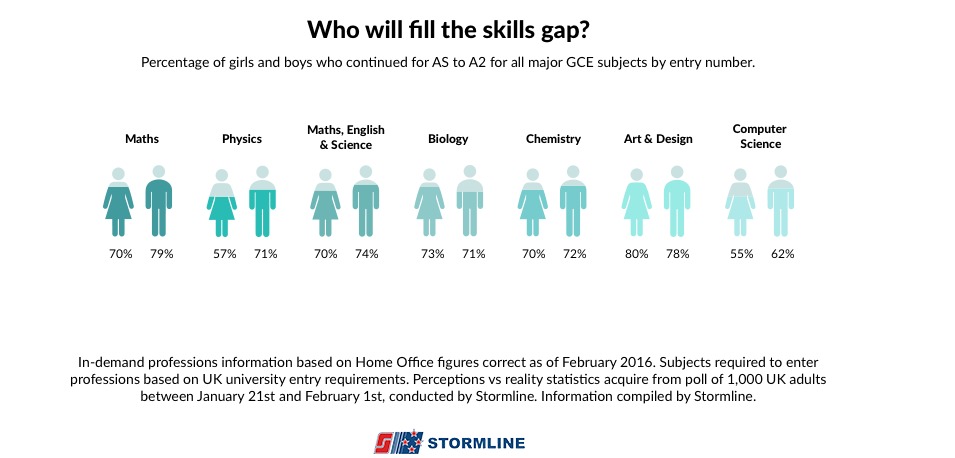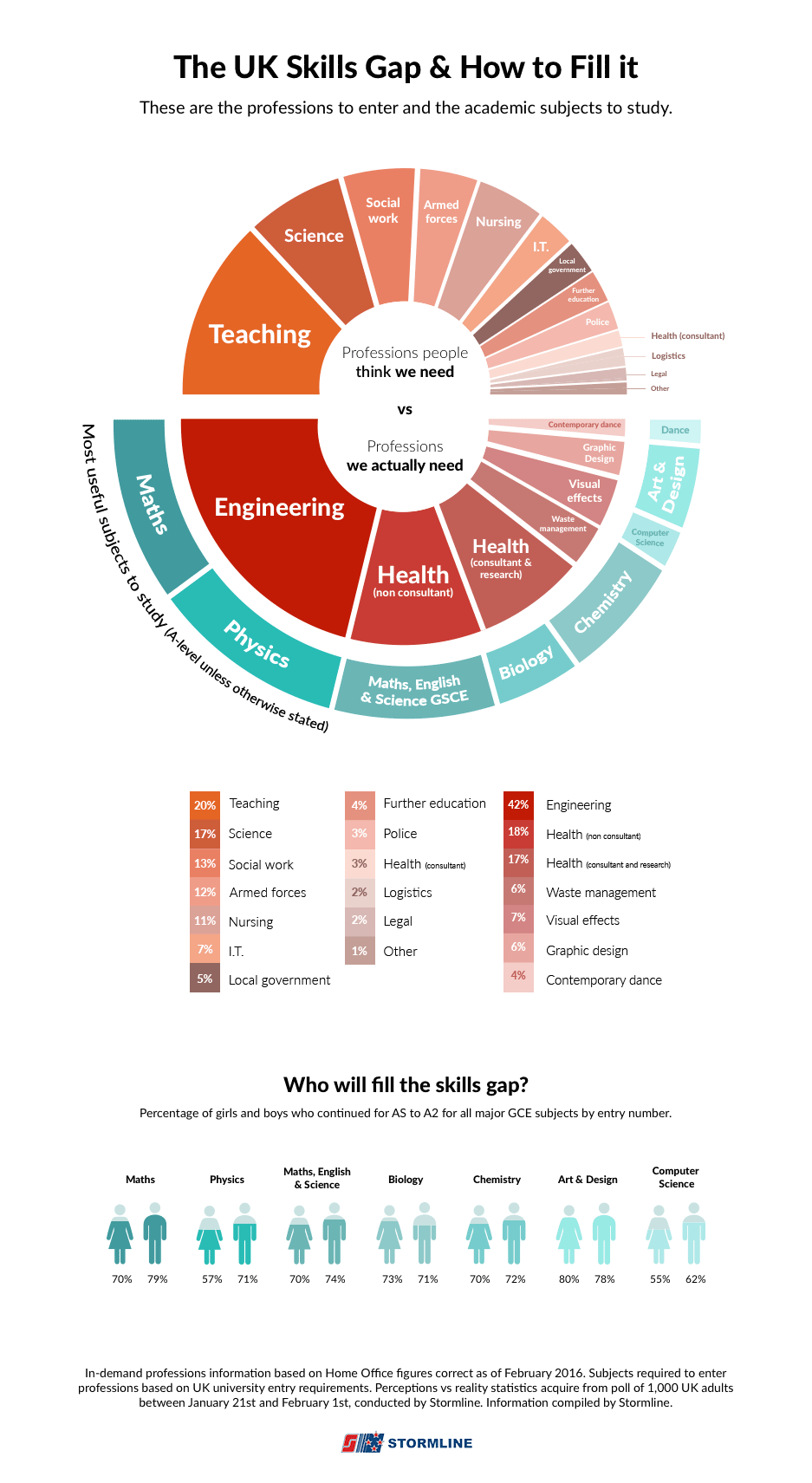The UK skills gap is a complex issue, especially when it comes to the matter of filling it. We recently conducted a study to see how familiar people are with the specific jobs that make up the skills gap. But instead of conducting a simple poll (yes we love polls), we made a game of it. We showed people a selection of job titles – some real and in-demand, others taken from sci-fi films, to see if they could tell which was which.
See the results or take the quiz for yourself. The results of the study were published far and wide, notably in The Telegraph and City AM to name a few.
We’ve done some more number crunching, this time to see exactly what jobs and skills the British public think we’re lacking. It’s safe to say, perceptions and reality don’t really match. Perhaps that is one of the biggest problems facing our economy. If people aren’t aware that we need dancers and designers as well as engineers, we’re missing a chance to attract people into the relevant areas of study.
Perception vs Reality
Our study asked 1,000 UK adults to select from a list of occupations which they believed were most in-demand. Interestingly, teaching generally was considered to be the most in-demand occupation, despite being a fairly well occupied profession, with only chemistry and maths teachers being listed on the Home Office website as in-demand.
Participants also believed professionals in social work, armed forces, I.T and local government were in-demand, despite the UK having no immediate shortage of any.
Engineering, health, waste management, visual design and contemporary dance were not identified in significant numbers, despite being the top in-demand occupations.
We also looked a bit further along the skills pipeline, to find out who will be filling the skills gap in the short to medium term.
Based on numbers of students pursuing relevant subjects at A and AS level, boys are more likely than girls to enter engineering professions, the sector with the largest immediate need for personnel. Girls will be represented in slightly higher numbers than boys in health care.
One of our past studies, which examined barriers to participation in so-called male dominated industries, suggested that fear of ‘macho’ work environments was one of the main reasons sectors such as engineering and waste management had an under-representation of females.
Skills Gap Data
Jobs needed, by sector.
| Engineering |
| Geotechnical Design Engineer |
| Geotechnical Specialist |
| Reservoir Panel Engineer |
| Rock Mechanics Engineer |
| Soil Mechanics Engineer |
| Geomechanics Engineer |
| Mining Geotechnical Engineer |
| Mining and Coal Engineer |
| Wells Engineer |
| Tunnelling Engineer |
| Petroleum Engineer |
| Drilling Engineer |
| Completions Engineer |
| Fluids Engineer |
| Reservoir Engineer |
| Offshore and Subsea Engineer |
| Control and Instrument Engineer |
| Process Safety Engineer |
| Mechanical Engineer in the Aerospace Sector |
| All electrical engineers in the oil and gas industry |
| Power System Engineer |
| Control Engineer |
| Protection Engineer |
| Any Appropriate |
| Design Engineer in the Electricity Transmission and Distribution Industry |
| Simulation Development Engineer |
| Manufacturing engineer (process planning) in the aerospace sector |
| Simulation Development Engineer |
| Planning / Development engineer |
| Quality, Health, Safety and Environment (QHSE) Engineer |
| Geoenvironmental Specialist |
| Geoenvironmental Engineer |
| Contaminated Land Engineer |
| Landfill Engineer |
| Metallurgical / Mineral Processing Engineer |
| Aerothermal Engineer |
| Stress Engineer |
| Chief of Engineering |
| Advance Tool and Fixturing Engineer |
| Commissioning Engineer |
| Substation Electrical Engineer |
| Waste management |
| Operations Manager |
| Decommissioning Specialist Manager |
| Project / Planning Engineer |
| Radioactive Waste Manager |
| Radiological Protection Advisor |
| Project Engineer Proposals Engineer |
| Health (consultants) |
| Clinical Neurophysiology |
| Emergency Medicine |
| Genitourinary Medicine |
| Haematology |
| Neurology |
| Occupational Medicine |
| Forensic Psychiatry |
| General Psychiatry |
| Learning Disabilities Psychiatry |
| Old Age Psychiatry |
| Consultants in Paediatrics |
| Health (non consultant) |
| Anaesthetics |
| Paediatrics |
| General Medicine Specialities Delivering Acute Care Services (Intensive Care Medicine, General Internal Medicine (Acute)) |
| Emergency Medicine |
| General Surgery |
| Obstetrics and Gynaecology |
| Trauma and Orthopaedic Surgery |
| ST4 Level Trainees in Paediatrics |
| Social Worker in Children’s and Family Services |
| Specialist Nurse Working in Operating Theatres |
| Operating Department Practitioner |
| Specialist Nurse Working in Neonatal Intensive Care Units |
| HPC-Registered Diagnostic Radiographer |
| HPC-Registered Therapeutic Radiographer |
| Sonographer |
| Nuclear Medicine Technologist |
| Radiotherapy Technologist |
| Staff Grade and Associate Specialist (SAS) Doctors in Paediatrics |
How we got our data
Skills gap occupations: This data was compiled from the Home Office shortage occupations list, available on the Home Office website.
Academic subjects: This information was based on entry requirements to study the relevant subjects at degree level. We gathered our data from the UCAS website and websites of more than 100 British universities.
Understanding of skills gap: This information was taken from a poll of 1,009 UK adults, between the dates of January 21st and February 1st 2016.


This is rubbish – you have no idea about the data you reference in this item – stick with raincoats